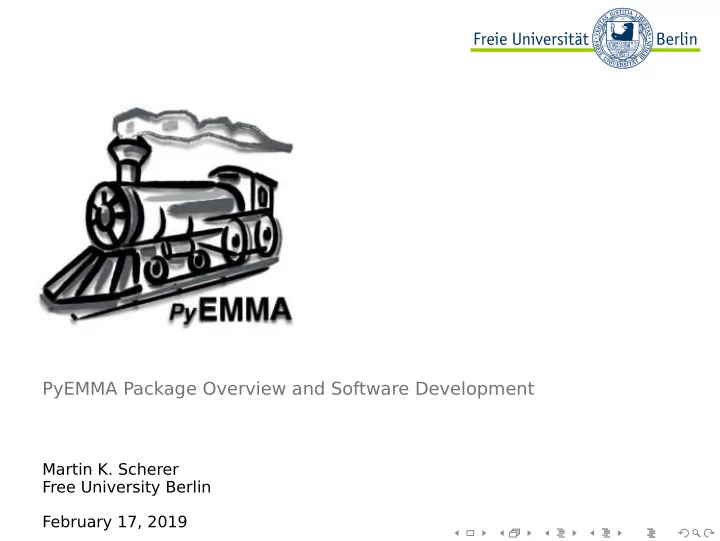

PyEMMA Package Overview and Software Development Martin K. Scherer Free University Berlin February 17, 2019
Outline Software overview and design patterns Python Anaconda stack Package overview Coordinates package MSM package PyEMMA Development Principles Processes GitHub Continous Integration Services Collaboration
Outline Software overview and design patterns Python Anaconda stack Package overview Coordinates package MSM package PyEMMA Development Principles Processes GitHub Continous Integration Services Collaboration
Python in Data Science ◮ Easy to use core libraries (eg. NumPy, SciPy, Pandas, Jupyter, Matplotlib, . . . ) ◮ Scientific software for MD, data science, biology, chemistry . . . ◮ Easy to learn general purpose language ◮ Quick prototyping ◮ Glue together software written in faster languages (eg. C/C++, Fortran)
Anaconda Cloud and Conda package manager ◮ Anaconda is a (Python-based) software stack built for all three major platforms (Linux, OSX, Windows) ◮ Easy installation and upgrading, no need to compile anything yourself. ◮ Different software channels for different purposes (eg. Omnia [MD], BioConda [Bioinformatics], . . . ) ◮ Automatic handling of dependencies (conflict checking) ◮ Possibility to create isolated work environments (separate package versions etc.)
From MD data to Knowledge PyEMMA Python- Featurization Dim. reduction Discretization subpackage feature selection TICA k-means . coordinates discrete regspace VAMP MD data trajs ➜ [01] ... ➜ [02] ➜ [02] MSM estimation & validation Maximum likelihood (ML) MSM implied timescales convergence discrete Markov Bayesian MSM Chapman-Kolmogorov test trajs model ➜ [03] ➜ [03], [04], [07] ML hidden MSM identifying common problems Bayesian hidden MSM . msm ➜ [07] ➜ [08] MSM analysis spectral analysis metastable states with PCCA++ Markov stationary properties TPT model Knowledge kinetic properties ➜ [05] uncertainty estimation Experimental observables ➜ [04] ➜ [06]
Package hierarchy - abstracting detailedness User- PyEMMA Interface: High-level Functionality / Detailedness API (abstract) User-friendliness coordinates msm thermo plots Implementation (detailed) MDTraj MSMTools BHMM Thermotools Matplotlib Implementation C/C++ Fortran NumPy SciPy (very detailed) extensions extensions
Principles of coordinate package ◮ Streaming data pattern ◮ Avoid the need of dumping intermediate results to disk ◮ Support for multiple data formats ◮ Random access possible (either simulated or IO efficient) Featurization Dim. reduction Discretization k-means feature selection TICA discrete regspace VAMP MD data trajs ➜ [01] ➜ [02] ... ➜ [02] Figure: Workflow: state space discretisation
Readers / Data sources ◮ All readers are Python-“iterable”, which means you can process data in chunks. The more general concept in PyEMMA is called ‘DataSource‘. my_source = pyemma.coordinates.source([’traj001.xtc’, ...) 1 for element in my_source: 2 print (element) 3 Supported reader data formats: ◮ MD-simulation data (XTC, DCD, . . . via MDTraj) ◮ NumPy (.npy) files ◮ T abulated ASCII data (around three times more efficient than Numpy.loadtxt) ◮ Fragmented trajectories [(’sim_0_part0.xtc’, ’sim_0_part1.xtc’), ’sim_1_part0.xtc’, ’sim_1_part1.xtc’)]
MDTraj Python package for reading/writing and analyzing molecular trajectories. Analysis functions: ◮ distances ◮ bonds/angles/dihedrals ◮ hydrogen bonding identification ◮ secondary structure assignment ◮ NMR observables ◮ . . . and many more Supported formats: ◮ DCD ◮ binpos ◮ XTC ◮ NetCDF ◮ TRR ◮ LH5 ◮ PDB ◮ HDF5 ◮ XYZ ◮ . . .
MSM package MSM estimation & validation Maximum likelihood (ML) MSM implied timescales convergence discrete Markov Bayesian MSM Chapman-Kolmogorov test trajs model ➜ [03] ➜ [03], [04], [07] ML hidden MSM Bayesian hidden MSM identifying common problems ➜ [07] ➜ [08] MSM analysis spectral analysis metastable states with PCCA++ Markov stationary properties TPT model Knowledge kinetic properties ➜ [05] uncertainty estimation Experimental observables ➜ [06] ➜ [04] Figure: MSM estimation and analysis workflow.
MSM package User-API examples Step Goal API function (all in pyemma.msm package) 1.a choose lag time its = timescales_msm(dtrajs) 1.b choose lag time (visual pyemma.plots. inspection) plot_implied_timescales(its) 2 estimate a model msm_obj = estimate_markov_model(dtrajs, lag) 3.a validate model ck_obj = msm_obj.cktest() 3.b validate model (vis. in- pyemma.plots.plot_cktest(ck_obj) spection) 4.a Analyze slow processes msm_obj.timescales() etc. 4.b Perform coarse graining coarsed = msm_obj.pcca() 4.c Transition path analysis coarsed.tpt()
Outline Software overview and design patterns Python Anaconda stack Package overview Coordinates package MSM package PyEMMA Development Principles Processes GitHub Continous Integration Services Collaboration
Principles ◮ Use Python as the glue to faster languages (C/C++, Fortran) ◮ Stable and easy to use high level user interface ◮ Open source (GNU Lesser Public license 3+, minimal restrictions on redistribution) ◮ Open development process on GitHub (everybody can contribute) ◮ Focus on speed and stability (NumPy, SciPy under the hood) ◮ Focus on good documentation (see http://emma-project.org)
Development processes ◮ GitHub as frontend (collect issues/bugs, discuss proposed changes, plan new features, . . . ) ◮ Continuous integration/deployment (Travis-CI, AppVeyor, custom Jenkins instances) ◮ Unit-tests for API and implementation ◮ Integration tests of notebooks ◮ Release bug fixes regularly ◮ Release major/minor versions, if API changes. ◮ Preserve API compatibility (deprecate functions first, to notice users, that in the future their program/scripts will not work the same way as before)
Releasing and deploying ◮ Before a release we freeze acceptance of new features (their milestone gets postponed to the next release) ◮ T esting sessions - eliminate all found bugs ◮ Deploy source archive to PyPI (installable with pip) and binaries to Anaconda.org binary services. ◮ Version scheme: Major.minor.micro major = major new (and API break features) minor = new features preserving existing API micro = patches/bug fixes
GitHub Figure: PyEMMA GitHub page
Collaboration on GitHub 1. Propose a change/feature via an issue 2. Create a local branch in Git to work on 3. Push the (tested) branch to your fork 4. Open a “pull request” (PR) on main repository (markovmodel/PyEMMA) 5. Discuss changes, eventually add more commits 6. Maintainer merges your PR
Propose file change on GitHub
...continued
Participate ◮ Create a GitHub account to directly post issues ( preferred ). ◮ Join our channel on Gitter.im ◮ Send mails to the developers (more overhead for us, might not reach somebody in time).
Thank you for your attention! Further questions?
Recommend
More recommend